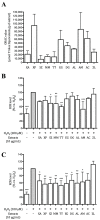Dietary Cameroonian Plants Exhibit Anti-Inflammatory Activity in Human Gastric Epithelial Cells
- PMID: 33321889
- PMCID: PMC7763248
- DOI: 10.3390/nu12123787
Dietary Cameroonian Plants Exhibit Anti-Inflammatory Activity in Human Gastric Epithelial Cells
Abstract
In Cameroon, local plants are traditionally used as remedies for a variety of ailments. In this regard, several papers report health benefits of Cameroonian spices, which include antioxidant and anti-microbial properties, whereas gastric anti-inflammatory activities have never been previously considered. The present study investigates the antioxidant and anti-inflammatory activities of hydro-alcoholic extracts of eleven Cameroonian spices in gastric epithelial cells (AGS and GES-1 cells). The extracts showed antioxidant properties in a cell-free system and reduced H2O2-induced ROS generation in gastric epithelial cells. After preliminary screening on TNFα-induced NF-κB driven transcription, six extracts from Xylopia parviflora, Xylopia aethiopica, Tetrapleura tetraptera, Dichrostachys glomerata, Aframomum melegueta, and Aframomum citratum were selected for further studies focusing on the anti-inflammatory activity. The extracts reduced the expression of some NF-κB-dependent pro-inflammatory mediators strictly involved in the gastric inflammatory process, such as IL-8, IL-6, and enzymes such as PTGS2 (COX-2), without affecting PTGS1 (COX-1). In conclusion, the selected extracts decreased pro-inflammatory markers by inhibiting the NF-κB signaling in gastric cells, justifying, in part, the traditional use of these spices. Other molecular mechanisms cannot be excluded, and further studies are needed to better clarify their biological activities at the gastric level.
Keywords: COX-2; Cameroonian plants; NF-κB; antioxidant; ethnopharmacology; gastric inflammation; interleukin 6; interleukin 8.
Conflict of interest statement
The authors declare no conflict of interest. The funder had no role in the design of the study; in the collection, analyses, or interpretation of data; in the writing of the manuscript, or in the decision to publish the results.
Figures





References
-
- Aihara M., Tsuchimoto D., Takizawa H., Azuma A., Wakebe H., Ohmoto Y., Imagawa K., Kikuchi M., Mukaida N., Matsushima K. Mechanisms involved in helicobacter pylori-induced interleukin-8 production by a gastric cancer cell line, mkn45. Infect. Immun. 1997;65:3218–3224. doi: 10.1128/IAI.65.8.3218-3224.1997. - DOI - PMC - PubMed
-
- Yasumoto K., Okamoto S., Mukaida N., Murakami S., Mai M., Matsushima K. Tumor necrosis factor alpha and interferon gamma synergistically induce interleukin 8 production in a human gastric cancer cell line through acting concurrently on ap-1 and nf-kb-like binding sites of the interleukin 8 gene. J. Biol. Chem. 1992;267:22506–22511. - PubMed
MeSH terms
Substances
LinkOut - more resources
Full Text Sources
Medical
Research Materials

